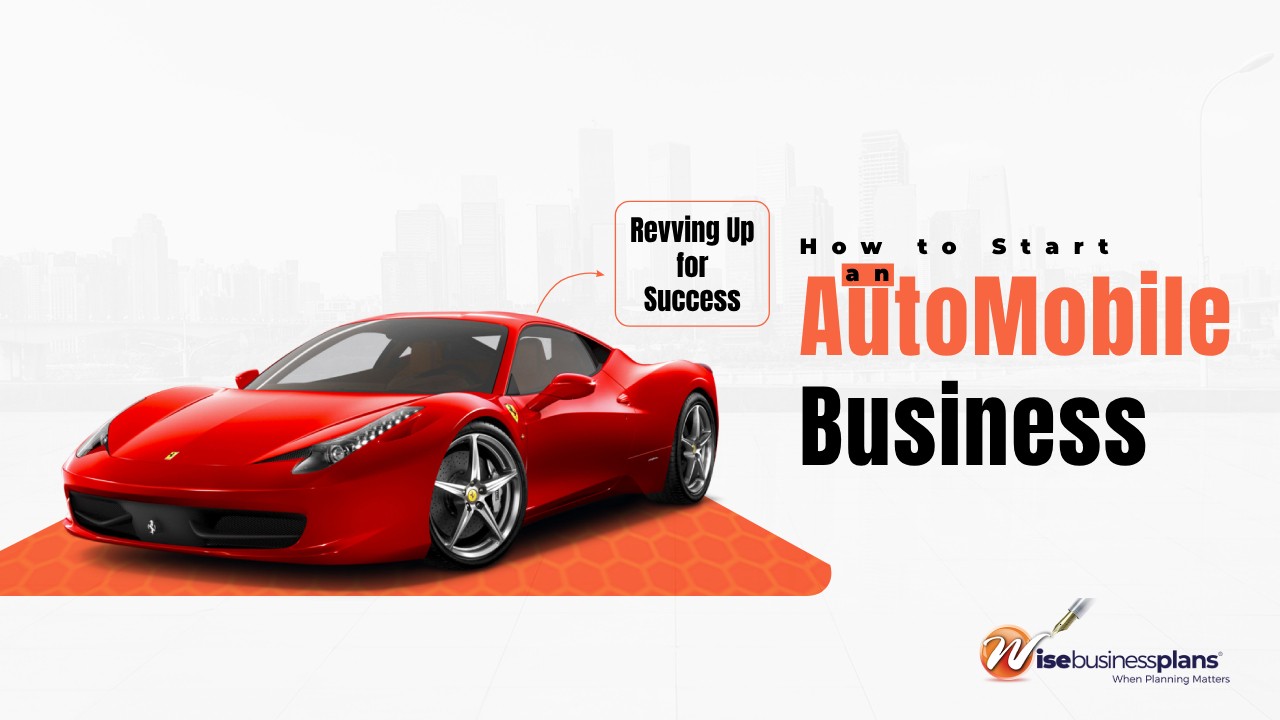How to Start an Automobile Business in 2024
Table of Contents
- Key Highlights
- Charting Your Course: Market Research and Niche Selection
- Understanding the Landscape:
- Finding Your Niche:
- Building The Business Plan
- Gearing Up: Licenses, Permits, and Legalities
- Licensing and Permits:
- Add Funding and Investment
- Building Your Skilled Personnel Team
- Selecting Location and Facilities
- Optimizing Your Facilities:
- Marketing Your Target Audience
- Staying Ahead of the Curve: Embracing Innovation
- The Road to Success: Perseverance and Continuous Improvement
- Conclusion
The automobile industry is a constant hum in the engine of our society. From the roar of muscle cars to the quiet purr of electric vehicles, automobiles play a vital role in our lives. If you’re passionate about cars and possess an entrepreneurial spirit, then starting an automobile business could be your dream venture. But before you hit the gas, it’s crucial to have a roadmap for success. This comprehensive guide will equip you with the knowledge and steps needed to navigate the exciting world of auto entrepreneurship.
Key Highlights
- Plan Your Path: We will discuss types of automobile and how to conduct market research, identify the niche in the auto industry and write a strong business plan.
- Build Your Foundation: We will discuss how to build your foundation by securing licenses and permits, obtain funding, assemble a skilled team with ongoing training, and choose a strategic location with optimized facilities.
- Thrive in the Fast Lane: We will discuss how to stay updated on industry trends, market your business effectively, and prioritize exceptional customer service for lasting success.

Get Our Professional Business Plan Writing Services Now!
Charting Your Course: Market Research and Niche Selection
Understanding the Landscape:
The auto industry is a broad spectrum, encompassing various sectors. Here’s a breakdown of some key types of Automobile Businesses:
- Manufacturing: This involves designing, developing, and producing vehicles or components. It requires significant capital investment and expertise. Examples include major car manufacturers like Ford or Toyota, as well as companies specializing in specific components like brakes or tires (e.g., Continental AG).
- Sales and Distribution: This includes dealerships that sell new and used cars, as well as wholesalers who distribute vehicles to dealerships. Franchise dealerships like Chevrolet dealerships or independent used car dealerships fall under this category.
- Service and Repair: This sector caters to maintenance and repair needs, ranging from general mechanics to specialized body shops. This could include chains like Meineke or Jiffy Lube offering general maintenance, or independent body shops specializing in collision repair or custom paint jobs.
- Aftermarket Parts and Accessories: This encompasses the vast market for parts and accessories that enhance car performance or personalization. This includes retailers selling performance parts or car audio equipment, as well as online marketplaces offering a wide variety of aftermarket parts.
Finding Your Niche:
Conducting thorough market research is paramount. Analyze local demographics, competitor landscape, and identify unmet needs. Here are some questions to consider:
- What type of vehicles are most popular in your target area (luxury, fuel-efficient, SUVs)?
- Are there gaps in the service offerings (e.g., lack of electric vehicle repair specialists)?
- Is there a growing demand for specific customization options (window tinting, sound systems)?
By pinpointing a niche, you can tailor your business strategy to cater to a specific clientele and stand out from the competition.
Building The Business Plan
A well-written business plan is your roadmap to success. It outlines your vision, goals, and strategies for navigating the competitive auto market. Here are key components to include:
- Executive Summary: Briefly introduce your business, its niche, and unique value proposition.
- Company Description: Detail your mission, ownership structure, and management team’s experience.
- Market Analysis: Analyze industry trends, target market demographics, and competitor landscape.
- Services Offered: Clearly define the specific services you’ll provide, catering to your chosen niche.
- Marketing and Sales Strategy: Outline your plan for attracting customers, including advertising, promotions, and customer service strategies.
- Financial Projections: Create realistic financial forecasts, including startup costs, operational expenses, projected revenue, and funding requirements.
Seeking Guidance: Consider seeking assistance from a professional business consultant or a Small Business Administration (SBA) representative. They can provide valuable insights and ensure your plan is comprehensive and realistic.
Checkout Our Professional Business Plan Examples Now!
Gearing Up: Licenses, Permits, and Legalities
Licensing and Permits:
Regulatory requirements vary depending on your location and business type. Here’s a general overview:
- Business License: Obtain a general business license to operate legally.
- Occupational Licenses: Specific licenses may be required for technicians performing repairs or mechanics working on emissions systems.
- Environmental Permits: Depending on your services (e.g., body shops using paint), environmental permits might be necessary for proper waste disposal.
- Business Registration: Choose a legal structure for your business, such as sole proprietorship, partnership, or Limited Liability Company (LLC). Each structure has different tax implications and liability protection. Consult with a lawyer or accountant to determine the best structure for your needs.
- Insurance: Secure adequate insurance coverage for your business, including general liability, property damage, and worker’s compensation.
Add Funding and Investment
Starting an auto business can require significant capital investment. Here are some financing options to consider:
- Self-Funding: Utilizing personal savings or investments can be an option, but ensure you have a financial cushion.
- Small Business Loans: Banks and credit unions offer loans specifically tailored to small businesses.
- Angel Investors: Wealthy individuals may invest in your business in exchange for equity or ownership stake.
- Venture Capital: Venture capitalists can provide substantial funding for businesses with high growth potential, but often require a strong business plan and a proven track record.
- Crafting a Compelling Pitch: When seeking funding, prepare a clear and concise pitch that showcases your business’s potential for growth and profitability. Highlight your market research, competitive advantage, and experienced management team.
Grow your business with our small business loans now!
Building Your Skilled Personnel Team
- Identify Skill Needs: Define the specific skillsets required for your chosen niche, whether it’s certified mechanics, experienced salespeople, or detailers with a keen eye.
- Crafting Job Descriptions: Develop clear and concise job descriptions that highlight the responsibilities, qualifications, and compensation offered for each position.
- Recruitment Strategies: Leverage online job boards, industry publications, and local technical schools to connect with qualified candidates. Consider attending career fairs or partnering with trade schools to tap into a fresh talent pool.
- Offering Competitive Compensation and Benefits: Competitive salaries, benefits packages (health insurance, paid time off), and opportunities for professional development can attract and retain skilled employees.
- Investing in Training: The auto industry is constantly evolving, with new technologies and repair techniques emerging. Provide ongoing training for your team to ensure they stay current with the latest advancements. Consider partnering with equipment manufacturers or parts suppliers who offer training programs.
Selecting Location and Facilities
Location plays a crucial role in attracting customers and ensuring operational efficiency. Here are key factors to consider:
- Visibility: Choose a location with high visibility and easy access from major roads.
- Drive-by Traffic: Depending on your business model (retail vs. service), prioritize areas with high foot traffic (for parts stores) or convenient drive-by access (for service bays).
- Proximity to Target Market: Locate yourself in an area where your target clientele resides or frequents.
- Space Requirements: Consider the space needed for your operations, including service bays, showroom space (if applicable), storage for parts and inventory, and customer waiting areas.
Optimizing Your Facilities:
- Layout and Workflow: Design a layout that facilitates efficient workflow, minimizing unnecessary movement for both staff and customers.
- Equipment and Tools: Invest in high-quality tools and equipment specific to your chosen niche. Consider leasing or financing options if upfront costs are prohibitive.
- Customer Amenities: Create a comfortable and welcoming environment for your customers. Provide a clean waiting area with Wi-Fi and refreshments, if possible.
- Maintaining a Clean and Professional Image: Regularly maintain your facilities, ensuring cleanliness and a professional presentation.
Marketing Your Target Audience
In today’s digital age, a strong marketing strategy is crucial for reaching your target audience and generating leads. Here are some effective strategies to consider:
- Developing a Strong Brand Identity: Create a logo and branding that reflects your company’s values and resonates with your target market.
- Building a Website: Establish a user-friendly website showcasing your services, highlighting customer testimonials, and providing clear contact information. Optimize your website for local search to increase online visibility.
- Embracing Social Media: Utilize social media platforms like Facebook, Instagram, and YouTube to connect with potential customers. Share engaging content, showcase your expertise, and run targeted advertising campaigns.
- Content Marketing: Develop valuable and informative content, such as blog posts or videos, addressing car maintenance tips, industry trends, or new services offered. This establishes your expertise and attracts organic traffic to your website.
- Building Partnerships: Collaborate with local car clubs, auto parts suppliers, or towing companies for cross-promotion opportunities.
- Exceptional Customer Service: Providing exceptional customer service is paramount to building trust and fostering loyalty. Ensure clear communication, timely repairs, and fair pricing to keep your customers coming back.
Get Our Professional Business Plan Writing Services Now!
Staying Ahead of the Curve: Embracing Innovation
The auto industry is undergoing a significant transformation, with electric vehicles (EVs) and autonomous driving becoming increasingly prominent. To remain competitive, consider these strategies:
- Staying Up-to-Date with Industry Trends: Attend industry conferences, trade shows, and training programs to stay abreast of the latest advancements and technologies.
- Investing in EV Expertise: If your focus is on maintenance and repair, consider specializing in servicing electric vehicles. This positions you to cater to a growing market segment.
- Adapting Your Business Model: Be open to adapting your business model to accommodate new technologies. This could involve offering installation services for EV charging stations or partnering with car-sharing platforms.
By embracing innovation and staying ahead of the curve, you can ensure your auto business thrives in the ever-evolving automotive landscape.
The Road to Success: Perseverance and Continuous Improvement
- Be Patient: Building a successful business takes time. Focus on delivering excellent customer service, building trust, and establishing a strong reputation.
- Embrace Feedback: Actively solicit feedback from your customers to identify areas for improvement and enhance your service offerings.
- Continuously Learn and Adapt: The auto industry is dynamic. Stay committed to learning new skills, exploring new technologies, and adapting your business to changing market trends.
- Celebrate Milestones: Take time to celebrate successes, big and small. This acknowledges your hard work and keeps your team motivated.
Conclusion
The world of automobiles is a thrilling and ever-evolving landscape. By following these steps, conducting thorough research, and remaining passionate about the industry, you can transform your dream of starting an auto business into a reality. Remember, success is a journey, not a destination. Embrace the challenges, celebrate the victories, and keep your engine running to propel your auto business towards lasting success.



![How to Implement Security Measures That Actually Protect Your Business [Step-by-Step Guide]](https://wisebusinessplans.com/wp-content/uploads/2025/06/how-to-implement-security-measures-that-actually-protect-your-business-1024x576.webp)











